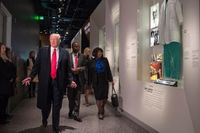The nation’s museums are facing a storm of controversy as President Donald Trump’s administration intensifies its scrutiny of the Smithsonian Institution, sparking warnings from historians and museum professionals that these moves could have far-reaching effects on public trust and the country’s understanding of its own past.
On August 12, 2025, the White House sent a detailed letter to Smithsonian Institution Secretary Lonnie Bunch III, outlining a sweeping review of eight of the nation’s most prominent museums. According to The Associated Press, the review will focus on the National Museum of American History, the National Museum of Natural History, the National Museum of African American History and Culture, the National Museum of the American Indian, the National Air and Space Museum, the Smithsonian American Art Museum, the National Portrait Gallery, and the Hirshhorn Museum and Sculpture Garden.
The White House directive calls for a thorough assessment of all public-facing content, including exhibition texts, social media posts, and educational materials. The stated goal? To evaluate the tone, historical framing, and alignment with what the administration describes as “American ideals.” The letter insists that the initiative is intended “to ensure alignment with the President’s directive to celebrate American exceptionalism, remove divisive or partisan narratives, and restore confidence in our shared cultural institutions.”
But many in the museum field and the historical community are not convinced. Cesáreo Moreno, visual arts director and chief curator at the National Museum of Mexican Art, expressed deep concern about the consequences of such a review. “If you pretend that you don’t make mistakes, I think you end up with a very shallow understanding of who you are, and your identity is inaccurate,” Moreno told The Associated Press. He argued that efforts to simplify patriotism and Americanism risk erasing the complexity and beauty of American identity.
President Trump’s public criticisms of the Smithsonian have only heightened tensions. On September 2, 2025, he took to Truth Social to lambast the museums, writing: “The Smithsonian is OUT OF CONTROL, where everything discussed is how horrible our Country is, how bad Slavery was, and how unaccomplished the downtrodden have been — Nothing about Success, nothing about Brightness, nothing about the Future. We are not going to allow this to happen.” Trump further described the museums as “the last remaining segment of ‘WOKE.’”
These comments came as the administration began expanding its review beyond the National Museum of African American History and Culture to other Smithsonian sites. According to reporting by The Independent, the review is part of a broader campaign, initiated by a March 2025 executive order, to “restore truth and sanity to American history” by purging what the administration calls “divisive narratives that distort our shared history.”
Some of the “divisive narratives” identified by the administration include acknowledgment of transgender athletes and in-depth analysis of slavery. The White House’s letter to the Smithsonian set a strict timeline: museums must submit exhibit materials and drafts for upcoming events within 30 days, and within 120 days, they are expected to take corrective action by “replacing divisive or ideologically driven language with unifying, historically accurate, and constructive descriptions.”
The impact is already being felt. In April 2025, the National Museum of African American History and Culture sparked controversy when it announced the return of several artifacts to donors, including Harriet Tubman’s book of hymns and a Bible carried during a civil rights protest. NBC News reported on the removals, which many saw as a response to Trump administration policies. However, museum officials defended the actions as routine and independent of the White House, explaining that artifacts are often returned based on loan agreements or to rotate displays.
Yet, the administration’s pressure is unmistakable. Trump has publicly threatened to pull federal funding from institutions that do not comply with his agenda, a tactic already used against universities such as Harvard and Johns Hopkins, which have seen millions in funding revoked. “This Country cannot be WOKE, because WOKE IS BROKE,” Trump declared on Truth Social, adding that he had instructed his attorneys to apply the same “process that has been done with Colleges and Universities where tremendous progress has been made.”
Historians are alarmed by these developments. Leslie Harris, professor of history and African American studies at Northwestern University, pushed back against the administration’s framing. “This is a very simplistic take on historians and museum professionals, this idea that they are looking to create a divide, or that they are creating a bad history to point fingers at someone — that is not the point,” Harris told The Associated Press. “The point is to make sure that we have a fair representation of all the people who have committed to creating the United States, to creating the present that we live in, and to think about things that maybe we do want to replicate in the future and things that we don’t want to replicate in the future. Those aren’t divisive issues. That’s historical information that actually can give people a greater sense of a common goal moving forward.”
For months, Smithsonian museums have been quietly reviewing, and at times removing, certain artifacts to comply with the administration’s directives. As The Independent reports, federal references to historically prominent Black Americans have been minimized, while references to white Americans, including Confederate figures, are being restored. Defense Secretary Pete Hegseth announced plans to rename military bases after controversial Confederate soldiers or generals, further fueling debate about how the nation chooses to remember its past.
The National Park Service has also come under fire for removing mentions of Harriet Tubman and the Underground Railroad from its website earlier this year. After facing significant backlash, Park Service leaders restored the references, insisting the changes had been unauthorized.
While the administration insists the review is about restoring unity and accuracy, critics warn it could erode the public’s trust in museums and their role as stewards of the nation’s collective memory. “More importantly, it’s now clear to me that this administration can reach down into all of those communities and destroy this history,” said Harris. “It’s going to be tough. I have no illusions about that, but we remember. And more people than ever, Black, White, every group that makes up a part of this nation, knows the truth, and more and more knows the truth, and we are not here for these lies.”
As the Smithsonian’s review unfolds, the stakes are clear: at issue is not only the content of museum exhibits, but the very nature of how Americans confront—and learn from—their shared history. The coming months will reveal whether the nation’s museums can preserve their integrity and independence in the face of unprecedented political pressure.




